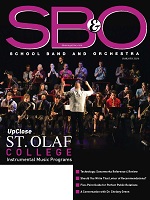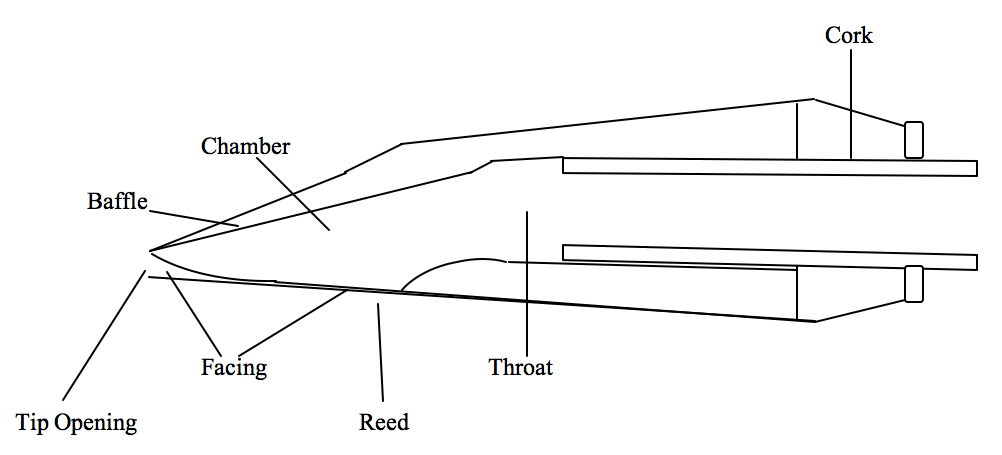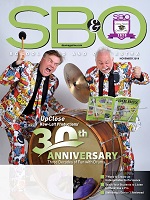By Lindsey Berthiaume
Every band director wants to improve the sound of his or her reed section for timber, control, and tone production. The single best way to do this is through mouthpiece and reed education so that students are able to identify and improve their own sound without direction from the conductor. The first step in educating students is becoming informed, yourself, so that you are able to pass on knowledge and insight.
Mouthpiece and reed combinations are a bit of a Pandora’s Box. In fact, the topic may be totally overwhelming unless you have experienced reed playing for a number of years. My suggestion is that you focus on a few basics, mouthpieces, the components of them, and reeds. By understanding the basic construction and selection techniques, you will be able to better assist your players in making sounds decisions with their own playing equipment. Look for a few main themes to focus on within your reed section for each half of the year. It may be reed selection, reed care, and preparation or perhaps mouthpieces will be where you direct your focus. Take this theme and teach them the basics, so that they are able to make better choices for themselves while playing and crafting their talents.
Mouthpieces
Plastic
The mouthpiece is one of the most important parts of the instrument and should be treated accordingly. Often students use the mouthpiece that comes with the instrument, which is great for beginning students as they learn how to care for and feed their instrument. This plastic stock mouthpiece will quickly have served its purpose and students will need to move to a better quality mouthpiece within the first year or two.
You might ask, “Why move them to a better mouthpiece so soon?” Plastic mouthpieces are in fact cheaper in price, which makes them great for the beginning band student; however you will quickly discover that they are cheaper for a reason. These pieces will often produce squeaks and squawks outside of normal student playing, produce mediocre tone, at best, and lead to an imbalance of the registers. Not to mention the warping, cracking and chipping on impact. Plastic mouthpieces are a good deal initially, but certainly not the right tool for developing good tone, timbre, and register balance.
Hard rubber and metal
A good hard rubber mouthpiece will serve you and your students well for many years. These mouthpieces are more durable than plastic and stand the test of time. The tone production is much improved, creating a warmer and more balanced sound for the player. Also, you don’t have to purchase the top of the line hard rubber mouthpiece. In fact, Vandoren and Selmer produce excellent quality and performance pieces that are moderate in price and really do last. A middle of the road mouthpiece, such as Selmer’s C* series is a reliable piece at a good price. When you get your reed section to seek out a better quality mouthpiece you will find that not only their playing improves, but also their motivation increases ten fold. It is a rite of passage as students move up to a better quality mouthpiece and their response to the improvements will be dramatic.
What to say about metal mouthpieces…? Well, it’s not something that I suggest. I will beg and plead with parents and students not to buy them until they’re ready. Not only is the sound scary – and it really is – but they’re hard to control and produce unreliable sounds and results. I think that there is some confusion surrounding metal mouthpieces. People want the edgy bright sound, but don’t realize that they can get a hard rubber mouthpiece with the right construction and configuration that will produce the same effect. I think it’s great that students recognize that they need a different sound for various genres of music, but we need to educate them as to how to get these sounds, so that they can make decisions that will help them grow as players.
Mouthpiece construction basics
The best way to change your sound is to know a little bit about the construction of a mouthpiece and seek out the appropriate type for you needs.
Let’s start by discussing the chamber of the mouthpiece: this is the inside part that is shaped like a hollow tube. This tube can be small, which produces higher and brighter tones that are used for jazz, rock, and pop. On the other hand, it can be a large chamber, which highlights the low tones that are more appropriate for classical music. The facing of the mouthpiece is the curved flat part that is covered by the reed. Where the reed and the tip of the mouthpiece start to move away from each other is known as the tip opening. The tip opening affects the tone and timbre of the sound. A larger tip opening uses a softer reed and produces a darker sound appropriate for classical music. A smaller tip opening uses a harder reed and produces a brighter sound more akin to jazz. Within the chamber, facing and tip opening categories there are endless combinations. You’ll need to identify the sound that you are trying to obtain and then look for the various construction elements that will lead you to this sound.
Overall
A good mouthpiece, which does not mean an expensive mouthpiece, will serve you, your students and the band well. It will help the students produce a better tone quality, even registers and improve their control. A middle of the road mouthpiece would be optimal as it can work well in both classical and jazz settings. One such mouthpiece would be the Selmer C* series. Students will find the results almost instantaneous and be motivated by their improved sound and equipment.
Reeds
Introduction
There are some days where it seems as though there is no rhyme or reason to reeds and their responses. Reeds are the single largest variable for any wind player or director and they have a huge impact on sound production and, more importantly, morale.
The best cane is grown in the south of France and is sold here by various manufacturers. The response and reliability is good, but you pay a little more for this. The inexpensive reeds are good for young and beginning students as they learn how to care for them, but it would be advisable to move to a better quality reed once they have discovered that breaking in new reeds isn’t that much fun. A better reed quality means extended life, better tone production, and response – the price increase is well worth these benefits.
Selection
Choosing the right reed for the job is half the battle. The first issue is selecting a “good reed,” with the second being selecting the “right cut” of reed for the music you are playing.
Selecting a good reed comes down to knowing the criteria: creamy bark and an even cut. I teach this to my students from the very beginning to ensure that they know the difference between a good reed and a bad one, empowering them to decide for themselves what will and won’t work. Often we play a game: dump out a box of reeds, and separate the good from the bad. This shows me that they know the difference and shows them that within a box of ten there may only be four or five reeds that are truly good.
With more advanced students, they can learn about and discover the various cuts of reeds and when to use them. There are really two cuts of reeds: a rock-jazz-pop reed that is thinner at the heart producing a brighter tone such as Vandoren’s Java; and a more classical reed that is thicker at the heart producing a darker tone. Knowing the difference between the two types will allow more advanced players to select not only a good reed, but also the appropriate cut of reed for the job. Sometimes as an experiment, I have the students play the classical reeds on the jazz tunes and vice-versa so that they can feel the difference between the two cuts, firsthand. Knowledge about their equipment is empowering – it gives students responsibility and ownership over their choices.
Preparation and Breaking-in Tricks
Breaking-in a reed is a process that we all must go through to get to the true sound and heart of a reed. This process involves having at least three reeds to rotate at any given time. The first step is to soak the reed in warm water for two minutes or so and then to play it for a short timeframe, such as twenty minutes, and then to move to another reed and repeat the same process. By rotating the reeds, we are breaking them in gradually and extend their life, as no one reed is played more than the others. Breaking a group in means that you will have not one, but three good reeds to chose from on any given day.
If the reeds are unresponsive, there are a few tricks you can use. One option is to sand the back of the reed – the side that connects with the facing – with the finest sandpaper you can find to even out the surface. A few strokes across the sandpaper will even out the reed and improve its response to air flow. Another option is to smooth the reed out while it is on the mouthpiece. Lick your thumb and rub the reed with the grain, from bottom to top until you feel as though the reed is getting smoother. It may feel like there are tiny grains coming off the reed and this is the feel that you want. You will need to rub the reed with your wet thumb about twenty-five times before it starts to get smooth, but it works for any stiff reeds.
Care and Maintenance
There is nothing grosser than reeds that have never been washed. You should wash the reed just with lukewarm water at least once a week, so that they don’t become slimy. This practice prolongs the life of the reed and reduces the amount of bacteria. Be sure to have students store their reeds on a flat surface such as a reed guard to reduce warping and protect the tip. Eating before you play is the single largest killer of reeds across the nation. Do your part to prevent this by not eating before you play. If you do eat before you play, be sure to brush your teeth or rinse you mouth with water at the very least. The sugar in your saliva breaks down the reed and also dries and hardens in your instrument.
Overall
With good knowledge of reeds, what a good reed is, how to store them, and what types to use when, your students will be able to make choices about their own performance and preparation. This knowledge really gives them the power to improve their sound and tone on a moment’s notice and without the benefit of your words of wisdom. They can pass on this knowledge to others in the section or even within the class to create a well-informed reed section with improved tone production and timbre.
Conclusion
Reeds and mouthpieces are a huge factor in performance. The variable combinations the right setup of reed and mouthpiece creates a better tone, timbre, and free blowing through the instrument. By teaching your students about reeds and mouthpieces and looking for further resources, you become better informed. Hopefully, this information allows you to take back the control from the reeds and give that control to the student. Their newfound knowledge will serve them well as they will be able to better adapt to reed and playing conditions and improve as budding musicians.
Ms. Berthiaume holds a B.F.A. honors in music from York University, a MAED in adult education and distance learning from the University of Phoenix and is currently finishing a B.E.d from the University of Toronto (May 2005).
Lindsey has been doubling on woodwinds for the past 10 years on saxophones, flute, clarinets, oboe, ney, mey and xiao. Her specialty in ethnomusicology has enabled her to go beyond the normal reed doubling and expand into the world music scene. As a performer she has been able to use her instrumental doubling skills in a variety of western and non-western playing idioms. Ms. Berthiaume is a sought out private teacher and clinician in the Toronto area specializing in world music and woodwind doublings.






























